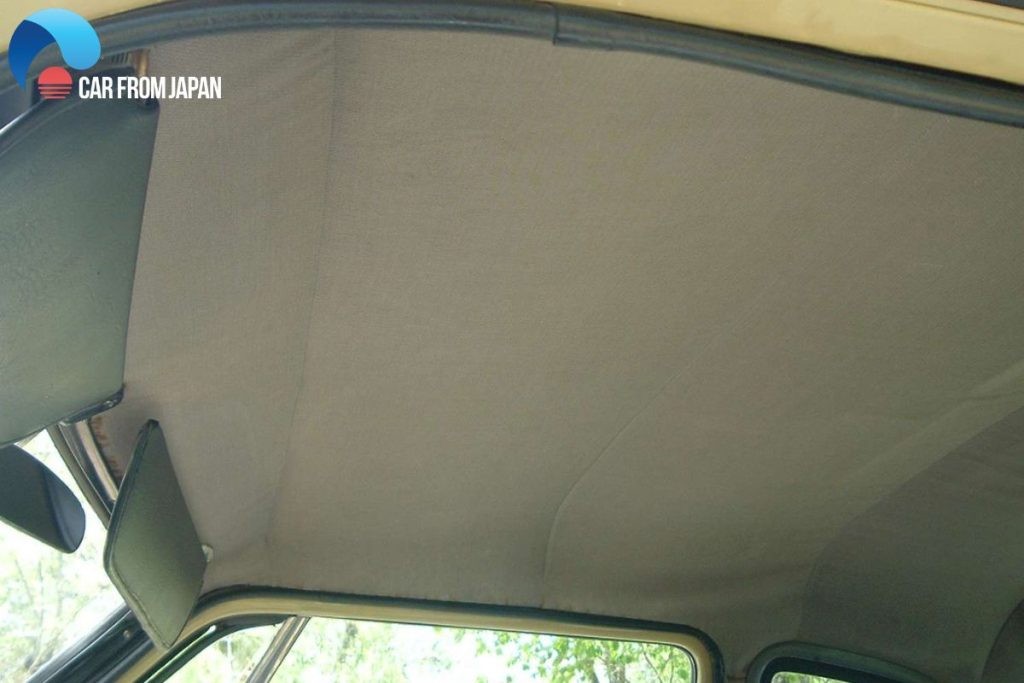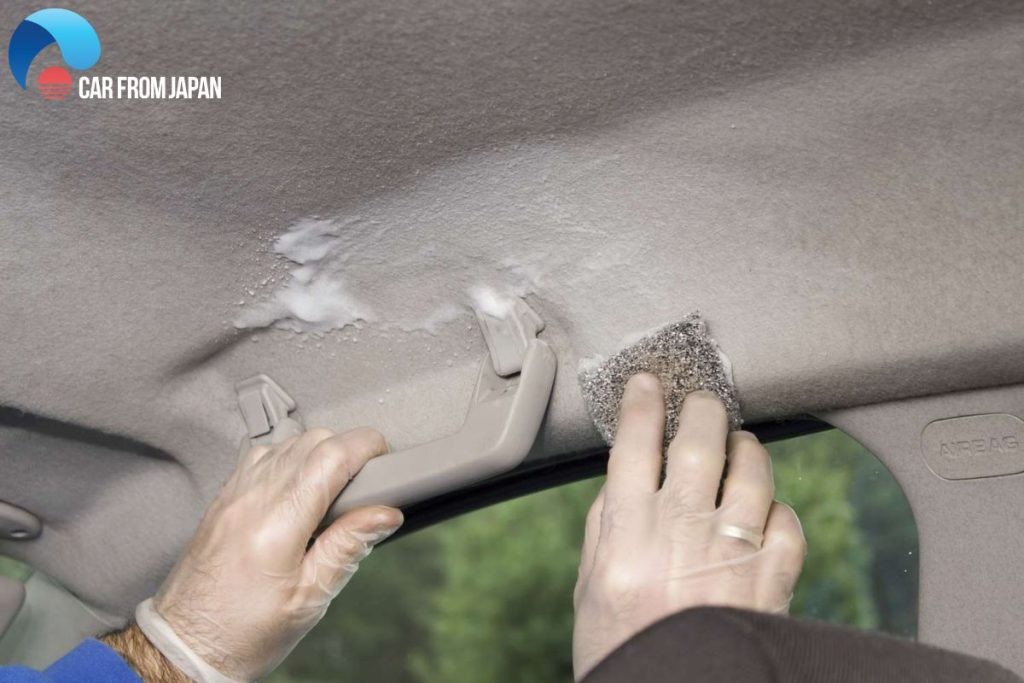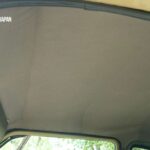How To Repair Auto Headliner? AUTO-REPAIR-TRAINING.EDU.VN is your ultimate resource, offering expert guidance and insights into automotive repair and career advancement. Addressing a sagging headliner is essential, not just for aesthetics, but also for maintaining your vehicle’s value and comfort, making skills in auto headliner repair a valuable asset for anyone aiming to excel in auto mechanics or manage a successful auto repair shop. Explore AUTO-REPAIR-TRAINING.EDU.VN for ASE certification, business plan samples, and step-by-step tutorials.
Contents
- 1. Understanding the Auto Headliner
- 2. Why Do Auto Headliners Sag?
- 2.1. The Impact of Heat and Sunlight
- 2.2. The Role of Moisture
- 2.3. The Problem of Poor Installation
- 2.4. The Effects of Physical Strain
- 3. Techniques on How to Repair Auto Headliner Without Removing It
- 3.1. Applying Adhesive for Headliner Repair
- 3.2. Using Pins for a Quick Headliner Fix
- 3.3. Employing Twist Pins for Headliner Repair
- 3.4. Steaming and Rolling for Headliner Restoration
- 4. Preventing Headliner Sagging
- 4.1. Avoiding Harsh Treatments
- 4.2. Parking Smart
- 4.3. Protecting the Interior
- 4.4. Maintaining Seals
- 4.5. Using Steam Cleaners Carefully
- 5. Headliner Replacement Costs
- 6. Repairing Auto Headliner: Conclusion
- 7. FAQs About Auto Headliner Repair
- 7.1. How Do You Know If Your Car Ceiling Is Sagging?
- 7.2. Is It OK to Fix the Headliner Sagging Myself?
- 7.3. Can I Paint a Headliner?
- 7.4. Does Car Insurance Cover the Cost of Car Headliner Replacement?
- 7.5. What Tools Do I Need to Repair a Sagging Headliner?
- 7.6. How Long Does It Take to Repair a Sagging Headliner?
- 7.7. Can High Humidity Cause Headliner Sagging?
- 7.8. What Are the Best Adhesives for Headliner Repair?
- 7.9. Is It Better to Repair or Replace a Sagging Headliner?
- 7.10. How Can I Find a Reputable Auto Repair Shop for Headliner Replacement?
1. Understanding the Auto Headliner
What exactly is a headliner in a car? A headliner is the fabric material affixed to the interior roof of a vehicle. Its primary functions include providing a finished aesthetic, absorbing sound, and offering insulation against temperature variations.
The headliner typically consists of several layers, often incorporating a foam backing, commonly made of polyurethane, which is either sprayed or adhered to a backing board. This design not only cushions the headliner but also enhances thermal and acoustic insulation within the vehicle’s cabin. Beyond aesthetics, the headliner significantly contributes to the vehicle’s overall comfort by minimizing noise intrusion and maintaining a consistent interior temperature. The enhanced insulation reduces the reliance on air conditioning and heating systems, which can improve fuel efficiency and reduce energy consumption.
 Car headliner is a fabric that is secured to the roof framing
Car headliner is a fabric that is secured to the roof framing
2. Why Do Auto Headliners Sag?
What causes car headliners to sag over time? Sagging headliners are a common issue in older vehicles, primarily caused by the degradation of the adhesive that bonds the fabric to the headliner board. This degradation is accelerated by several factors, including heat, humidity, and physical strain.
2.1. The Impact of Heat and Sunlight
Can heat and sunlight really damage a car headliner? Yes, prolonged exposure to heat and direct sunlight is a major factor in headliner degradation. The adhesive used to secure the headliner fabric can melt or dry out under high temperatures, causing the fabric to detach from the backing board.
This is particularly prevalent in regions with hot climates or during summer months when vehicles are frequently parked outdoors. According to a study by the National Highway Traffic Safety Administration (NHTSA), interior temperatures in a car parked in the sun can reach as high as 160°F (71°C) in a short period, significantly impacting the adhesive’s integrity.
2.2. The Role of Moisture
How does moisture affect a car headliner? Moisture, whether from humidity or leaks, can also wreak havoc on a headliner. The foam backing can absorb moisture, leading to the breakdown of the adhesive and the development of mold or mildew. This not only causes the headliner to sag but can also create unpleasant odors and potential health hazards. Regularly inspecting and addressing any leaks in your vehicle can help prevent moisture-related damage to the headliner.
2.3. The Problem of Poor Installation
Why does poor installation lead to sagging headliners? A subpar installation, characterized by insufficient adhesive or improper techniques, is a recipe for premature sagging. If the headliner was not properly secured from the start, it is more likely to detach and sag over time. Ensuring that headliners are installed by professionals who use quality materials and proper techniques can significantly extend their lifespan.
2.4. The Effects of Physical Strain
Can physical strain cause a headliner to sag? Yes, physical strain, such as that caused by children or pets pulling or scratching at the headliner, can accelerate its deterioration. The constant pressure and abrasion can weaken the adhesive and fabric, leading to sagging. Implementing measures to protect the headliner from physical damage, such as using seat covers or pet barriers, can help prolong its life.
3. Techniques on How to Repair Auto Headliner Without Removing It
Is it possible to repair a sagging headliner without removing it? Yes, there are several effective methods for repairing a sagging headliner without the need for full removal. These techniques are particularly useful for minor sagging issues and can save time and money compared to a complete replacement.
 How to fix sagging headliner
How to fix sagging headliner
3.1. Applying Adhesive for Headliner Repair
How effective is gluing in repairing a sagging headliner? Gluing is an effective method for addressing localized sagging, particularly around the edges or corners of the headliner. It involves applying a specialized headliner adhesive to re-bond the fabric to the backing board.
Ordinary glues are not suitable for this purpose as they may not withstand the temperature variations inside a vehicle and can damage the fabric. Spray adhesives are often preferred for their ease of application and even distribution. According to automotive repair experts, the best results are achieved by cleaning the affected area thoroughly before applying the adhesive and ensuring proper ventilation during the application process.
3.2. Using Pins for a Quick Headliner Fix
Can pins really fix a sagging headliner? Yes, pins can provide a quick and cost-effective solution for securing a sagging headliner. Sequin pins or similar types of pins can be used to push the fabric back into place and hold it against the backing board.
This method is particularly useful for temporary fixes or in areas where the sagging is not severe. The pins can be arranged in a pattern to enhance the visual appeal of the repair. While pins are not a long-term solution, they can prevent further sagging and improve the overall appearance of the headliner.
3.3. Employing Twist Pins for Headliner Repair
What are clear-headed twist pins and how do they work? Clear-headed twist pins, also known as saggy stoppers, are designed specifically for headliner repair. They offer a non-invasive and inexpensive way to secure the headliner without causing further damage.
These pins feature a clear plastic head that blends in with the headliner fabric and a twisted shaft that grips the backing board. They are easy to install and can be used even when the entire headlining is sagging. Twist pins are a better option than glue or tacks as they do not damage the fabric and can be easily removed if necessary.
3.4. Steaming and Rolling for Headliner Restoration
How can steam cleaning and paint rolling help repair a headliner? The combination of steam cleaning and paint rolling can be an effective method for reattaching the headliner fabric. The steam cleaner helps to soften the old adhesive, allowing the fabric to be re-bonded to the backing board.
Following the steam treatment, a paint roller is used to smooth out the fabric and ensure even adhesion without creases or wrinkles. This technique works best when the sagging is around the edges and requires careful application to avoid damaging the fabric. Using a high-quality steam cleaner and applying gentle pressure with the paint roller can yield professional-looking results.
4. Preventing Headliner Sagging
What steps can be taken to prevent headliner sagging? Preventing headliner sagging involves proactive measures to protect the headliner from the factors that cause it to degrade. These measures include protecting the vehicle from extreme heat and moisture, ensuring proper ventilation, and avoiding physical strain on the headliner.
4.1. Avoiding Harsh Treatments
Why should I avoid using home remedies on my car headliner? Home remedies such as hairspray, stapling, or pins can cause further damage to the headliner fabric and backing board. These treatments are not designed for automotive applications and can lead to discoloration, tearing, and other issues that are more difficult and costly to repair.
4.2. Parking Smart
How does parking in the shade help my car headliner? Parking your vehicle in the shade or using a car cover can significantly reduce the headliner’s exposure to heat and sunlight. This helps to prevent the adhesive from melting or drying out, thereby prolonging the life of the headliner. According to the Environmental Protection Agency (EPA), using a car cover can reduce interior temperatures by up to 25°F (14°C), which can make a significant difference in preventing headliner damage.
4.3. Protecting the Interior
How can I protect my car ceiling from damage? Ensuring that children and pets are kept secure in their seats can prevent them from pulling or scratching at the headliner. Using seat covers and pet barriers can provide an additional layer of protection. Additionally, avoiding storing heavy items against the headliner can prevent physical strain and sagging.
4.4. Maintaining Seals
Why is it important to check my car’s rubber seals? Regularly checking your vehicle’s rubber seals and addressing any leaks can prevent moisture from seeping into the headliner. Moisture can cause the foam backing to deteriorate and lead to the growth of mold and mildew. Ensuring that your vehicle is properly sealed can protect the headliner and maintain a healthy interior environment.
4.5. Using Steam Cleaners Carefully
What precautions should I take when using a steam cleaner on my car headliner? When using a steam cleaner to clean the headliner, it is important to avoid using too much pressure or steam. Excessive moisture can damage the fabric and backing board, leading to sagging. Using a low-pressure setting and keeping the steam cleaner moving can help prevent damage. Additionally, ensuring that the vehicle is well-ventilated during and after cleaning can help the headliner dry quickly and prevent the growth of mold and mildew.
5. Headliner Replacement Costs
How much does it typically cost to replace a sagging headliner? The cost to replace a sagging headliner can vary widely depending on the vehicle’s make and model, the type of fabric used, and whether you choose to have the work done by a professional or do it yourself. Generally, the average cost to replace a car’s headliner ranges from $300 to $1,000 or more.
| Vehicle Type | Estimated Cost |
|---|---|
| Simple-designed Sedan/Hatchback/Coupe (Accord/Corolla) | $300 – $750 |
| Large SUV/Crossover with Sunroof/Moonroof (RAV 4/X-Trail) | $500 – $900 |
| Luxury Vehicle (BMW) | $1,000 – $6,000+ |
6. Repairing Auto Headliner: Conclusion
How to repair auto headliner? Addressing a sagging headliner is essential for maintaining your vehicle’s appearance and comfort. By understanding the causes of headliner sagging and employing the appropriate repair techniques, you can restore your car’s interior to its former glory. Whether you opt for a DIY fix or professional replacement, addressing a sagging headliner is a worthwhile investment in your vehicle’s overall value and enjoyment. For comprehensive training and resources, visit AUTO-REPAIR-TRAINING.EDU.VN and take the first step towards mastering auto headliner repair and other essential automotive skills. Contact us at +1 (641) 206-8880 or visit our office at 200 N Michigan Ave, Suite 1500, Chicago, IL 60601, United States.
7. FAQs About Auto Headliner Repair
7.1. How Do You Know If Your Car Ceiling Is Sagging?
What are the signs of a sagging car ceiling? Signs of a sagging car ceiling include: A cracking sound when the car shakes, Drooping plasterboard sheeting, Visible cracks, Tiny circles or blisters.
7.2. Is It OK to Fix the Headliner Sagging Myself?
Can I fix a sagging headliner myself? Yes, you can fix minor headliner issues yourself. Replacement kits are available online and at auto parts retailers. These kits allow you to use small tools to secure the inner layer of the headliner.
7.3. Can I Paint a Headliner?
Is painting a headliner a good idea? Painting a headliner is not recommended. While it may seem appealing, it requires significant preparation and the paint may not withstand temperature changes within the car’s interior.
7.4. Does Car Insurance Cover the Cost of Car Headliner Replacement?
Will my car insurance cover headliner replacement? Most car insurance policies do not cover interior upholstery, trim, and headliners.
7.5. What Tools Do I Need to Repair a Sagging Headliner?
What tools are essential for headliner repair? Essential tools for repairing a sagging headliner include: Headliner adhesive, Sequin pins or twist pins, Steam cleaner, Paint roller, Cleaning supplies (such as fabric cleaner and a brush).
7.6. How Long Does It Take to Repair a Sagging Headliner?
How long should I expect headliner repair to take? The time required to repair a sagging headliner depends on the extent of the damage and the method used. Minor repairs using adhesive or pins may take a few hours, while more extensive repairs or replacements can take a full day.
7.7. Can High Humidity Cause Headliner Sagging?
How does humidity contribute to headliner sagging? High humidity can cause the foam backing of the headliner to absorb moisture, leading to the breakdown of the adhesive and the development of mold or mildew. This can cause the headliner to sag and create unpleasant odors.
7.8. What Are the Best Adhesives for Headliner Repair?
Which adhesives work best for headliner repair? The best adhesives for headliner repair are those specifically designed for automotive headliners. These adhesives are formulated to withstand high temperatures and provide a strong, durable bond.
7.9. Is It Better to Repair or Replace a Sagging Headliner?
Should I repair or replace my sagging headliner? Whether to repair or replace a sagging headliner depends on the extent of the damage. If the sagging is minor and localized, a repair may be sufficient. However, if the entire headliner is sagging or the fabric is severely damaged, replacement may be the better option.
7.10. How Can I Find a Reputable Auto Repair Shop for Headliner Replacement?
How do I find a good auto shop for headliner replacement? To find a reputable auto repair shop for headliner replacement, consider the following steps: Seek recommendations from friends, family, or online reviews, Check for certifications and affiliations with reputable organizations, such as ASE, Obtain estimates from multiple shops and compare prices and services, Ensure the shop offers a warranty on their work.
